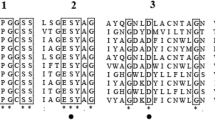Abstract
X-prolyl dipeptidyl aminopeptidases (X-PDAPs) are useful in various food industries. In this study, we performed sequence-based screening to obtain a stable X-PDAP enzyme from thermophilic Streptomyces strains. We found three genes that encoded X-PDAP from Streptomyces thermoluteus subsp. fuscus NBRC 14270 (14270 X-PDAP), Streptomyces thermocyaneoviolaceus NBRC 14271 (14271 X-PDAP), and Streptomyces thermocoerulescens NBRC 14273, which were subsequently cloned and sequenced. The deduced amino acid sequences of these genes showed high similarity, with ~80% identity with each other. The isolated X-PDAPs and an X-PDAP from Streptomyces coelicolor were expressed in Streptomyces lividans using a hyperexpression vector: pTONA5a. Among these genes, only 14270 and 14271 X-PDAPs caused overexpression and extracellular production without artificial signal peptides. We also characterized the biochemical properties of purified 14271 X-PDAP. In addition, we found that, in peptide synthesis via an aminolysis reaction, this enzyme recognized d-amino acid derivatives as acyl acceptors, similar to l-amino acid derivatives.



Similar content being viewed by others
References
Byun, T., Kofod, L., & Blinkovsky, A. (2001). Synergistic action of an X-prolyl dipeptidyl aminopeptidase and a non-specific aminopeptidase in protein hydrolysis. Journal of Agricultural and Food Chemistry, 49(4), 2061–2063.
Yoshpe-Besançon, I., Gripon, G.-I., & Ribadeau-Dumas, B. (1994). Xaa-Pro-dipeptidyl-aminopeptidase from Lactococcus lactis catalyses kinetically controlled synthesis of peptide bonds involving proline. Biotechnology and Applied Biochemistry, 20, 131–140.
Ota, T., Itoh, A., Tachi, H., Kudoh, K., Watanabe, T., Yamamoto, Y., et al. (2005). Synthesis of morphiceptin (Tyr-Pro-Phe-Pro-NH) by dipeptidyl aminopeptidase IV derived from Aspergillus oryzae. Journal of Agricultural and Food Chemistry, 53(15), 6112–6116.
Hatanaka, T., Onaka, H., Arima, J., Uraji, M., Uesugi, Y., Usuki, H., et al. (2008). pTONA5: A hyperexpression vector in Streptomycetes. Protein Expression and Purification, 62, 244–248.
Hopwood, D. A., Bibb, M. J., Chater, K. F., Kiser, T., Bruton, C. J., Kiser, H. M., et al. (1985). Genetic manipulation of Streptomyces: A laboratory manual (pp. 70–84). Norwich: The John Innes Foundation.
Rawlings, N. D., O’Brien, E. A., & Barrett, A. J. (2002). MEROPS: The protease database. Nucleic Acids Research, 30, 343–346.
Prescott, J. M., & Wilkes, S. H. (1976). Aeromonas aminopeptidase. Methods in Enzymology, 45, 530–543.
Nowakowski, C. M., Bhomik, T. K., & Steele, J. L. (1993). Cloning of peptidase genes from Lactobacillus helveticus CNRZ 32. Applied Microbiology and Biotechnology, 39, 204–210.
Meyer-Barton, E. C., Klein, J. R., Imam, M., & Plapp, R. (1993). Cloning and sequence analysis of the X-prolyl-dipeptidyl-aminopeptidase gene (pepX) from Lactobacillus delbrückii spp. lactis DSM7290. Applied Microbiology and Biotechnology, 40, 82–89.
Kimura, K., Nagasawa, A., Fujii, M., & Itoh, Y. (2002). Cloning of the pepX Gene of Lactobacillus helveticus IFO3809 encoding salt-tolerant X-prolyl dipeptidyl aminopeptidase and characterization of the enzyme. Journal of Bioscience and Bioengineering, 93(6), 589–594.
Anastasiou, R., Papadelli, M., Geogalaki, M. D., Kalantzopoulos, G., & Tsakalidou, E. (2002). Cloning and sequencing of the gene encoding X-prolyl-dipeptidyl aminopeptidase (PepX) from Streptococcus thermophilus strain ACA-DC 4. Journal of Applied Microbiology, 93, 52–59.
Goldstein, J. M., Banbula, A., Kordula, T., Mayo, J. A., & Travis, J. (2001). Novel extracellular X-prolyl dipeptidyl-peptidase (DPP) from Streptococcus gordonii FSS2: An emerging subfamily of viridians Streptococcal X-prolyl DPPs. Infection and Immunity, 69(9), 5494–5501.
Hatanaka, T., Usuki, H., Arima, J., Uesugi, Y., Yamamoto, Y., Kumagai, Y., et al. (2011) Extracellular production and characterization of two Streptomyces L-asparaginases. Applied Biochemistry and Biotechnology (in press).
Arima, J., Uesugi, Y., Iwabuchi, M., & Hatanaka, T. (2008). Streptomyces aminopeptidase P: Biochemical characterization and insight into the roles of its N-terminal domain. Protein Engineering, Design & Selection, 21(1), 45–53.
Arima, J., Uesugi, Y., Iwabuchi, M., & Hatanaka, T. (2006). Study on peptide hydrolysis by aminopeptidases from Streptomyces griseus, Streptomyces septatus and Aeromonas proteolytica. Applied Microbiology and Biotechnology, 70, 541–547.
Kumar, I., & Pratt, R. F. (2005). Transpeptidation reactions of a specific substrate catalyzed by the Streptomyces R61 dd-peptidase: Characterization of a chromogenic substrate and acyl acceptor design. Biochemistry, 44, 9971–9979.
Kato, Y., Asano, Y., Nakazawa, A., & Kondo, K. (1990). Synthesis of d-alanine oligopeptides catalyzed by D-aminopeptidase in non-aqueous media. Biocatalysis, 3, 207–215.
Komeda, H., & Asano, Y. (1999). Synthesis of d-phenylalanine oligopeptides catalyzed by alkaline d-peptidase from Bacillus cereus DF4-B. Journal of Molecular Catalysis B, 6, 379–386.
Arima, J., Morimoto, M., Usuki, H., Mori, N., & Hatanaka, T. (2010). Aminolysis reaction of Streptomyces S9 aminopeptidase promotes the synthesis of diverse prolyl dipeptides. Applied and Environmental Microbiology, 76(12), 4109–4112.
Rahfeld, J., Schierhorn, M., Hartrodt, B., Neubert, K., & Heins, J. (1991). Are diprotin A (Ile-Pro-Ile) and diprotin B (Val-Pro-Leu) inhibitors or substrates of depeptidyl peptidase IV? Biochimica et Biophysica Acta, 1076, 314–316.
Leiting, B., Pryor, K. D., Wu, J. K., Marsilio, F., Patel, R. A., Crak, C. S., et al. (2003). Catalytic properties and inhibition of proline-specific dipeptidyl peptidases II, IV and VII. The Biochemical Journal, 371, 525–532.
Holst, J. J. (1997). Enteroglucagon. Annual Review of Physiology, 59, 257–271.
Deacon, C. F., Hughes, T. E., & Holst, J. J. (1998). Dipeptidyl peptidase IV inhibition potentiates the insulinotropic effect of glucagon-like peptide 1 in the anesthetized pig. Diabetes, 47, 764–769.
Acknowledgment
This work was supported by JSPS KAKENHI No. 20550158.
Author information
Authors and Affiliations
Corresponding author
Rights and permissions
About this article
Cite this article
Hatanaka, T., Yamasato, A., Arima, J. et al. Extracellular Production and Characterization of Streptomyces X-prolyl Dipeptidyl Aminopeptidase. Appl Biochem Biotechnol 164, 475–486 (2011). https://doi.org/10.1007/s12010-010-9149-z
Received:
Accepted:
Published:
Issue Date:
DOI: https://doi.org/10.1007/s12010-010-9149-z




